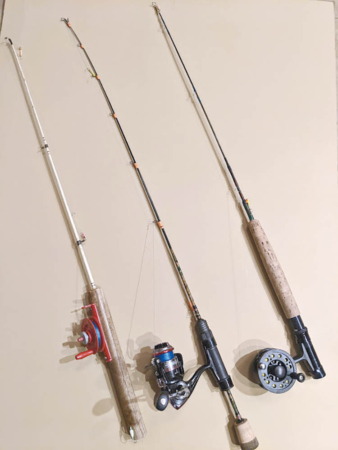Last week I began to delve a little deeper into the process of catching fish through a barrier of ice, and like any kind of fishing, the right tools used in the most proficient manner produce the best results. It’s probably safe to say that the most important tool for fishing comes down to the device that enables you to connect with and ultimately land your quarry, and that, of course, is the fishing rod and reel.
Actually, when it comes to ice-fishing, there is another device besides the rod and reel for hooking up to fish on the hard water, and that is something called a tip-up. There are actually a variety of tip-ups or gadgets that are used that are not held in your hand but rather are set on the ice and triggered by some mechanism that then tells the fisherman he has a strike. I still use the old pop-up flag tip-ups; they set over the hole with a simple reel mounted on a rod that sticks up above the ice. When a fish takes the bait, the reel turns and triggers a flag to pop up, signaling a fish is on the run. There was a time when I fished almost exclusively with tip-ups, and I caught plenty of fish; this type of ice-fishing tends to be more passive, so years ago, I added the jigging rod to my arsenal and increased my catch even more.
The rod and reel used for ice-fishing are far different than what is used for your typical day on the stream for trout or a lake for bass. Probably the biggest difference is the length of the rod. When ice-fishing, you want to be close to or actually nearly right over the hole; therefore, a short rod is needed; I’m talking two feet long or even less. I also match my rod to the fish I’m after; when panfishing, I like a sensitive and fairly light rod. I often make my own jigging rods from broken spinning rods since the tips are still good and they fit the bill. I still use ice-fishing outfits that I made from a section of broom handle with a rod tip inserted; a simple small plastic or metal spool with a handle completed the outfit. Today they make small spinning outfits just for ice-fishing-the rods and reels are reduced in size and work well for ice fishing. Broken flyrods work well, too; remove the broken rod from the handle and then attach the right-sized tip into the rod handle; you can even use the fly reel if you replace the fly line with monofilament.
In recent years I’ve been using more of the newer ice-fishing outfits-they look like miniature fly-fishing rigs; the reel actually resembles a fly reel and works similarly. I like these outfits because the reel is mounted on the handle like a traditional fly outfit; therefore, my fishing hand is in front of the reel, giving me more “feel” when it comes to detecting strikes.
I generally prefer to fish without a strike indicator; I simply lower my presentation to the desired depth keeping the line tight; a tight line is important since I rely on the feel of the tap or strike. The biggest mistake I see people make is to allow slack in the line; thus, a strike cannot be detected. I’ve also found that same situation to be true when fishing in open water in the summer; slackline doesn’t tell you when the strike occurs. You may also use a small bobber but adjust the bobber size to the fish you are after. When panfishing through the ice, I use just a big enough bobber to keep it on the surface, and at the slightest movement, I set the hook. Since you are allowed to have five devices in ice-fishing, I will often set three tip-ups out nearby and then jig with two rods-it can get busy at times.
Next week we will delve a little deeper into how to have a productive day on the hard water-now we need some good ice.




